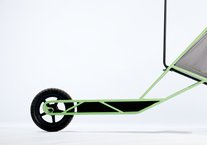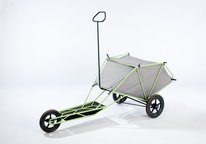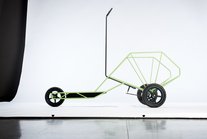Product designers honoured by the German Design Council for their cargo scooter
Bauhaus students Esther Betz, Elisa Bessega and Sylvia Chen have been honoured for their »Mantis« cargo scooter in the »one&twenty« design competition. With this international competition, the German Design Council annually honours outstanding design students and graduates in the fields of product design and lifestyle.
»Mantis« is characterised by its low weight. The three design students were able to achieve this with the help of bionic topology optimisation. In the case of the cargo scooter, the so-called soft-kill option method (SKO) was used: an algorithm based on natural bone growth that can generate corresponding structures. This algorithm does not create the design, but rather generates basic structural proposals in which the - statically considered - unnecessary parts of an object can be recognised and eliminated. These structural proposals are integrated into the subsequent design process in order to increase the fatigue strength of the product using less material. This saves weight and, as a result, CO2.
»Our focus was on using the material sparingly and in the best possible way,« explains Esther Betz. »SKO helped us to develop the steel frame, which has a high strength at a low weight, which ensures efficient material utilisation and improved stability.« Side steering and the spacious load basket provide a safe and intuitive user experience. Three wheels provide the necessary stability without compromising manoeuvrability. »Mantis« is a sustainable and user-friendly alternative to conventional cargo vehicles and can facilitate the transport of everyday loads in an urban environment.

»Mantis« von Esther Betz, Elisa Bessega und Sylvia Chen
Click the Play button to load and view external content from Vimeo.com.
Automatically load and view external content from Vimeo.com (You can change this setting at any time via our »Data protection policy«.)
The team of three students came together as part of a semester project in the Product Design degree programme at the Faculty of Art and Design at Bauhaus-Universität Weimar. The Italian Elisa Bessega studied at the Politecnico di Milano and Sylvia Chen at the Pratt Institute in New York. Both were in Weimar as part of a exchange semester and worked on the semester project with Esther Betz.
The project was supervised by Andreas Mühlenberend, Professorship »Industrial Design«, and the Artistic Associates Niklas Hamann and Moritz Neuner.
The award from the German Design Council comes with the opportunity to travel to the Salone del Mobile 2024 (16 to 21 April 2024), the Milan design fair, and take part in the »one&twenty« exhibition. There, the award-winning works will not only be presented to the public, but also to a professional audience - a very good opportunity to make important contacts. This year's competition attracted more than 800 entries from over 50 countries. As part of the exhibition opening on 15 April 2024, one project will also be named »Best of Best«.
About the competition
With the »one&twenty« competition (formerly »ein&zwanzig»), the German Design Council wants to give young designers the opportunity to exhibit their prototypes in Milan as part of the »Salone del Mobile 2024«. A total of 21 works will be selected and presented during the design fair. The international competition is aimed at design students and alumni with innovative and trend-setting work in the fields of product design and lifestyle.
About the German Design Council
The German Design Council is an independent and internationally active institution that supports companies in communicating design expertise efficiently and at the same time aims to strengthen the general public's understanding of design. Established as a foundation in 1953 on the initiative of the German Bundestag, the German Design Council promotes good design with its competitions, exhibitions, conferences, seminars and publications. Around 330 German and foreign companies are currently members of the German Design Council.
If you have any questions, please contact Romy Weinhold, Press and Public Relations Officer at the Faculty of Art and Design, by telephone on +49 / 36 43 / 58 11 86 or by e-mail at romy.weinhold[at]uni-weimar.de.
Kontakt
Bauhaus-Universität Weimar
Claudia Weinreich
Pressesprecherin
Tel.: +49(0)3643/58 11 73
Luise Ziegler
Mitarbeiterin Medienarbeit
Tel.: +49(0)3643/58 11 80
Fax: +49(0)3643/58 11 72
E-Mail: presse[at]uni-weimar.de
Web: www.uni-weimar.de/medienservice



